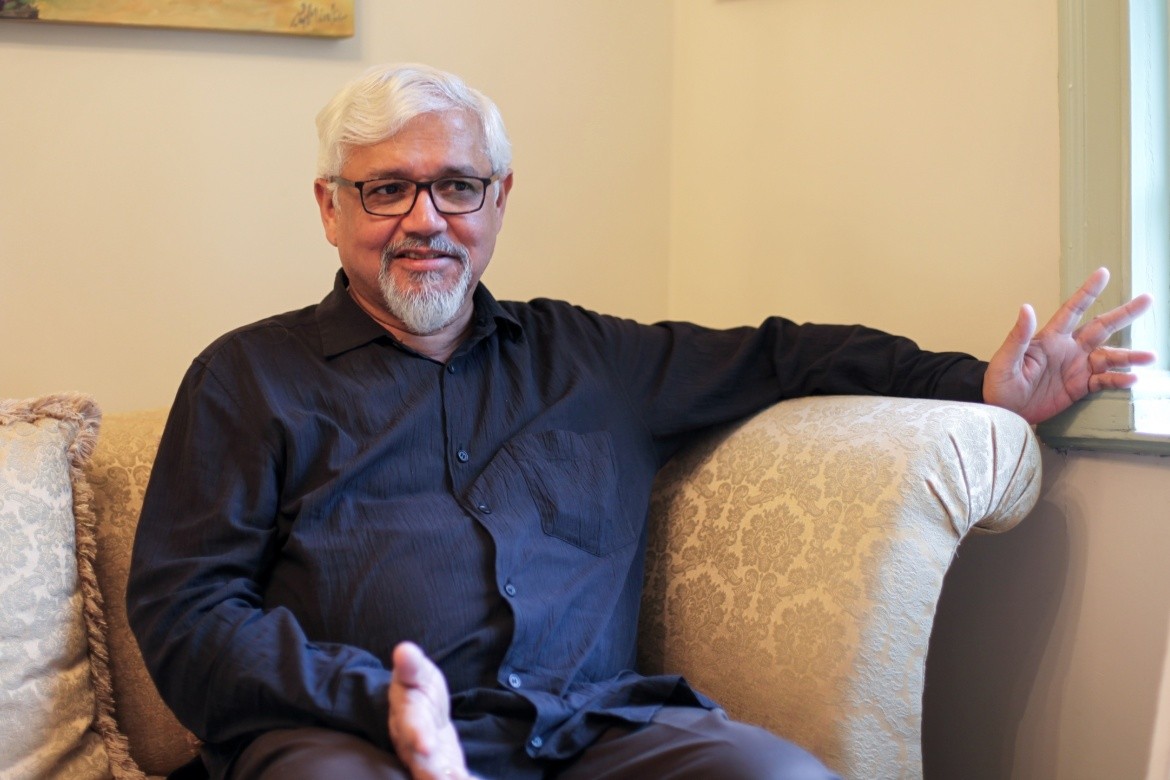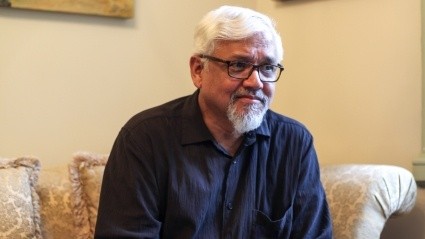Five questions for author Amitav Ghosh

Amitav Ghosh, the internationally known author, spoke about his work before giving a reading at Mount Holyoke.
Acclaimed Indian novelist Amitav Ghosh’s latest book, “Gun Island,” tells the story of a Brooklyn-based rare books dealer who becomes unexpectedly entangled with an ancient legend about Manasa Devi, the goddess of snakes. The book explores a wide cast of characters across the globe, from the Sundarbans to Los Angeles and Venice, and is set against a backdrop of upheaval and the catastrophic processes of displacement that are unfolding today.
Ghosh’s other novels include the award-winning “Ibis Trilogy,” which unfolds at the time of the Opium Wars and explores colonialism in the East. He has received extensive international recognition for his writing, including being shortlisted for the Man Booker Prize and the Man Asian Literary Prize. Two of his most recent honors include the Lifetime Achievement Award at the Times of India festival and the Jnanpith Award — he was the first Indian writer in English to have been chosen for this honor. Ghosh is on the faculty at Queens College, City University of New York and is a visiting professor at Harvard University. He lives in Brooklyn with his family.
Ghosh read from “Gun Island” at Mount Holyoke College on September 12 in an event sponsored by the McCulloch Center for Global Initiatives. This interview has been lightly edited and condensed for clarity.

Five questions for Amitav Ghosh
One of the many themes of “Gun Island” is climate change, a topic you’ve written about most recently in your nonfiction book “The Great Derangement: Climate Change and the Unthinkable.” What role does literature play in fighting global warming?
I don’t think of this book as being about climate change as such. I think of it as a book about the realities of the world we’re in. And the world we’re in is profoundly disturbed by climate change. Just think of the ways in which migration has destabilized the entire continent of Europe, and really, all of North America. We can already see the ways in which climate change is actually going to completely transform the world that we’re in.
I don’t think that one can segregate this as just being a matter of climate. It’s a much broader set of impacts. In the case of migration, there’s climate, there’s environmental degradation, which is a separate thing, really. And at the same time, there’s also technological impacts of various kinds. So all of these come together. I think what really what we’re seeing is a process of acceleration that extends through all our lives in so many ways.
What purpose does myth and folklore serve in your work?
If we are not to look at the world in that sort of mechanistic vein, which has actually given us the disaster that we’re in, then where do we look? And if you think of, say for example, the Indigenous people who were at Standing Rock fighting the pipelines, what were they drawing upon? Look at what’s happening at Mauna Kea today, where they’re trying to put a huge observatory on top of a mountain and the Indigenous peoples are resisting — because for them it’s a mountain that is in fact sacred. I think, in confronting this reality that we are in, we are in many ways trying to find different ways of thinking, different resources for thinking. Myth and folklore often are resources that we can draw upon, especially for writers.
Your first book, “The Circle of Reason,” received numerous awards after being published in 1986, including the Prix Médicis étranger, one of France’s top literary awards. What changes have you seen in Indian literature?
When I started as a writer, there were very few publishers in India. When I was in my teens it was very hard to buy books in India, very few bookstores. We had to buy secondhand books or get books from libraries. And now it’s completely different. There are many important publishers. The reading public is huge. Many English language publishers make a lot of money in India. It’s a huge market. So all of that has changed pretty dramatically. There are many more Indian writers who are available to everybody — they’re published in India but they’re also published abroad. They’re published here in the United States. So all of that has changed very dramatically. Being rich in literature and being rich in the infrastructure of publishing are two different things. The infrastructure of publishing has expanded to keep pace with the growing population of writers and readers.
What do you hope Mount Holyoke students will take away from hearing your talk and reading your book?
I don’t think my book has a message as such. I don’t think a novel can really be employed to spread messages. Mine is a novel about the real world and I hope it’s read, first and foremost. You know, because it’s an interesting story, and if there’s something else in it after that, then that’s a plus.
You’re a prolific writer of both fiction and nonfiction. What’s next on your agenda?
I’ve written a fair amount of nonfiction in my life. But I write less and less of it. Now when I sit down to write something, even if I sit down to write it as nonfiction, it suddenly changes into a story. I’m a pretty hardworking writer. I get to my desk, I don’t really waste a lot of time. You have to remember I don’t do anything else other than read and write. If I weren’t writing, I’d be bored out of my mind.